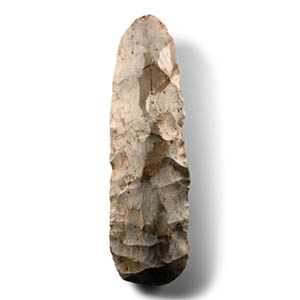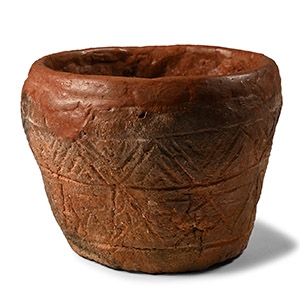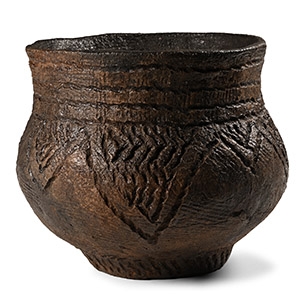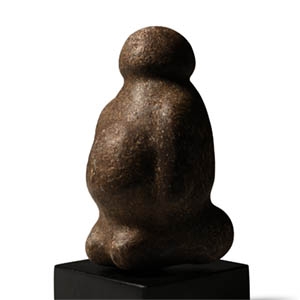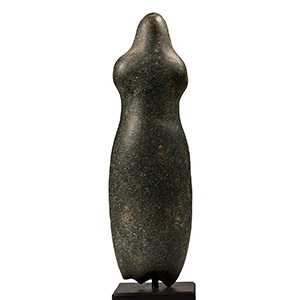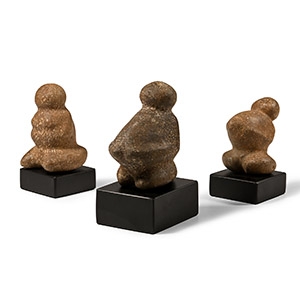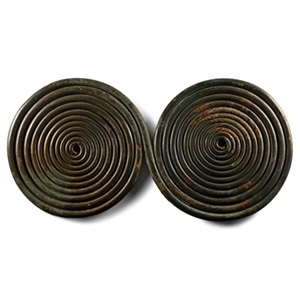Home > Auctions > 26 November - 1 December 2024
Ancient Art, Antiquities, Natural History & Coins
Found Old Sarum, Salisbury, Wiltshire, UK.
Acquired from Mr Edwards in November 2002.
From the private collection of Kenneth Machin (1936-2020), Buckinghamshire, UK; with collection no.N143; his collection of antiquities and natural history was formed since 1948; thence by descent.
Found in the Somme region of Northern France.
From the collection of amateur archaeologist Mr M. Allais, formed in the mid-1900s.
Acquired on the European art market.
From the private collection of an East Anglian, UK, collector.
The 'Lancelot' form is well regarded as a typology of handaxes from the Lower Palaeolithic.
Found Cranborne Chase, UK.
From a collection acquired on the UK art market from various auction houses and collections mostly before 2000.
From an important Cambridgeshire estate; thence by descent.
See Grinsel, L., The Ancient Burial-mounds of England, London, 1953.
Acquired in the late 1950s.
From the family collection of a South East London collector.
See Briard, J., The Bronze Age in Barbarian Europe, London, 1979, for discussion.
From a collection acquired on the UK art market from various auction houses and collections mostly before 2000.
From an important Cambridgeshire estate; thence by descent.
Cf. Morris, D., The Art of Ancient Cyprus, Oxford, 1985, figs.108-109, p.119, for similar idols; Various, Idoles, Au commencement etait l’image, A la Reine Margot, 22 Novembre 1990-28 Fevrier 1991, Paris, 1990, figs.10-11, for similar; also see Caldwell, Duncan, The Use of Animals in Birth Protection Rituals and Possible Uses of Stone Figurines from the Central Sahel, 2015 winter issue, vol.48, no.4, Nov., pp.14-25.
Most scholars consider these as symbols of the fertility cult and as evidence of the existence of a matriarchal society as a form of organisation of the earliest human society. The people of the Stone Age may have considered figures such as this to represent women and mothers with their life-giving powers, or as depictions of the ancestors.
From a collection acquired on the UK art market from various auction houses and collections mostly before 2000.
From an important Cambridgeshire estate; thence by descent.
Accompanied by an academic report by Dr Raffaele D’Amato.
This lot has been checked against the Interpol Database of stolen works of art and is accompanied by search certificate number no.12352-223252.
Cf. Morris, D., The Art of Ancient Cyprus, Oxford, 1985, figs.107-108, p.119, for similar idols; also see Caldwell, Duncan, ‘The Use of Animals in Birth Protection Rituals and Possible Uses of Stone Figurines from the Central Sahel’ in African Arts, UCLA, 2015 Winter issue, vol.48, no.4, Nov., pp.14-25, fig.5, letters Q-T, Y.
Most scholars consider these as symbols of the fertility cult and as evidence of the existence of a matriarchal society as a form of organisation of the earliest human society. The people of the Stone Age may have considered figures such as this to represent women and mothers with their life-giving powers, or as depictions of the ancestors.
From a collection acquired on the UK art market from various auction houses and collections mostly before 2000.
From an important Cambridgeshire estate; thence by descent.
Accompanied by an academic report by Dr Raffaele D’Amato.
This lot has been checked against the Interpol Database of stolen works of art and is accompanied by search certificate number no.12333-224213.
Cf. Morris, D., The Art of Ancient Cyprus, Oxford, 1985, figs.107-108, p.119, for similar idols; also see Caldwell, Duncan, ‘The Use of Animals in Birth Protection Rituals and Possible Uses of Stone Figurines from the Central Sahel’ in African Arts, UCLA, 2015 Winter issue, vol.48, no.4, Nov., pp.14-25, figs.5, letter Q.
Most scholars consider these as symbols of the fertility cult and as evidence of the existence of a matriarchal society as a form of organisation of the earliest human society. The people of the Stone Age may have considered figures such as this to represent women and mothers with their life-giving powers, or as depictions of the ancestors.
From a collection acquired on the UK art market from various auction houses and collections mostly before 2000.
From an important Cambridgeshire estate; thence by descent.
Accompanied by an academic report by Dr Raffaele D’Amato.
This lot has been checked against the Interpol Database of stolen works of art and is accompanied by search certificate number no.12351-223248.
Cf. Morris, D., The Art of Ancient Cyprus, Oxford, 1985, figs.107,109, p.119, for similar idols; Various, Idoles, Au commencement etait l’image, A la Reine Margot, 22 Novembre 1990-28 Fevrier 1991, Paris, 1990, figs. 10-11, for similar; also see Caldwell, Duncan, ‘The Use of Animals in Birth Protection Rituals and Possible Uses of Stone Figurines from the Central Sahel’ in African Arts, UCLA, 2015 Winter issue, vol.48, no.4, Nov., pp.14-25, fig.5, especially letters C,H,J.
Most scholars consider these as symbols of the fertility cult and as evidence of the existence of a matriarchal society as a form of organisation of the earliest human society. The people of the Stone Age may have considered figures such as this to represent women and mothers with their life-giving powers, or as depictions of the ancestors.
Ex Surrey, UK, collection, 1980s.
From a family collection mostly formed in the 1940s-1950s, thence by descent.
Acquired on the German art market, 2000.
Private collection, Europe.
From the private collection of Kenneth Machin (1936-2020), Buckinghamshire, UK; with collection no.C2; his collection of antiquities and natural history was formed since 1948; thence by descent.
Cf. Ehrenberg, M., Bronze Spearheads from Berks, Bucks and Oxon, BAR 34, Oxford, 1977, item 37, for type.
217 - 228 of 3419 LOTS

